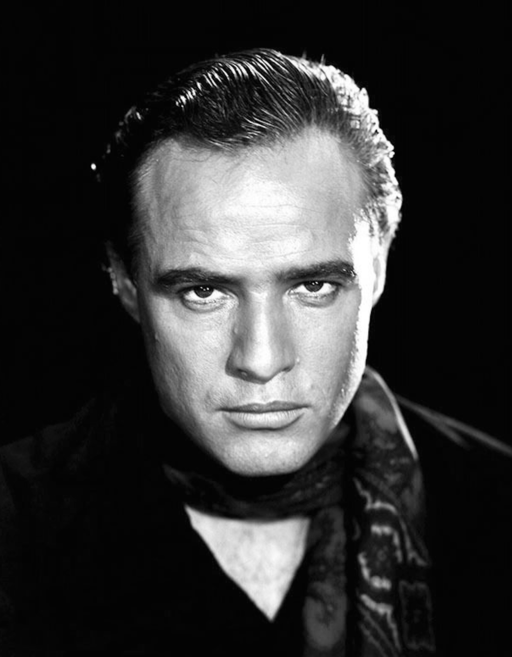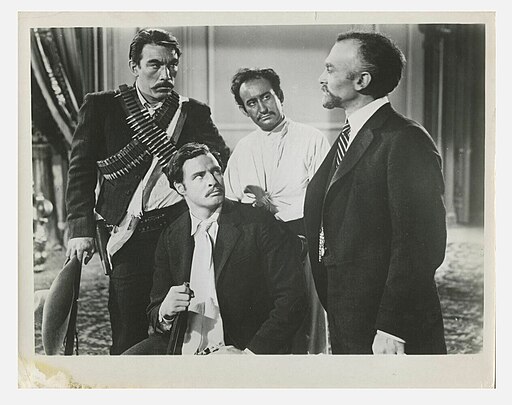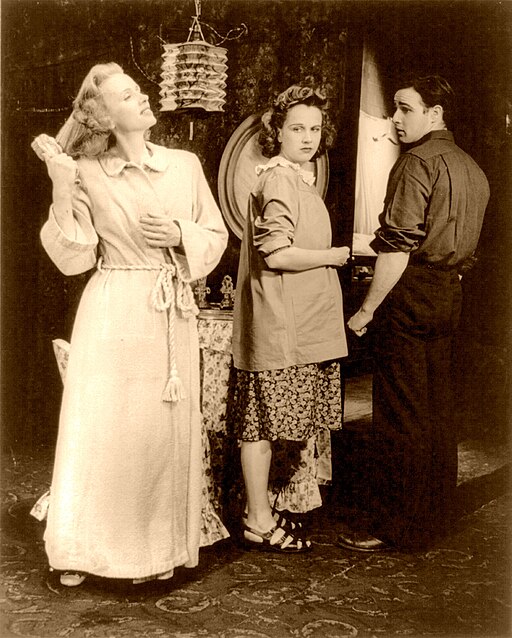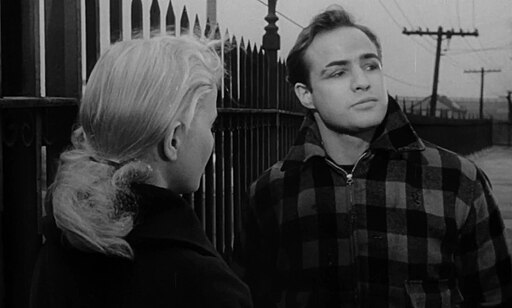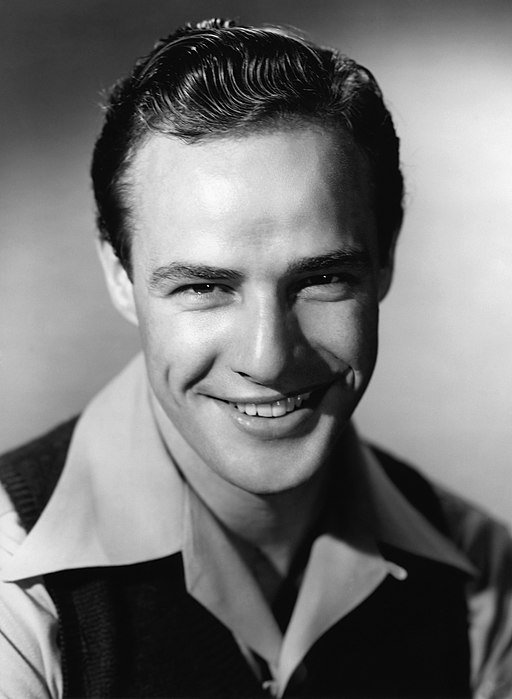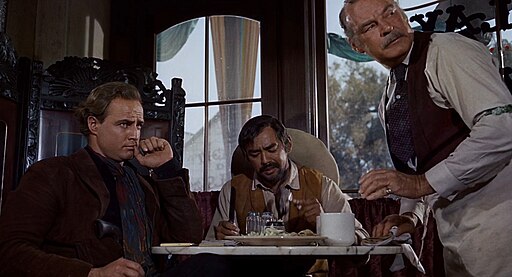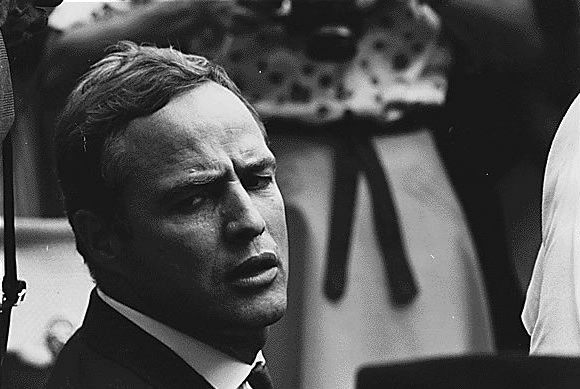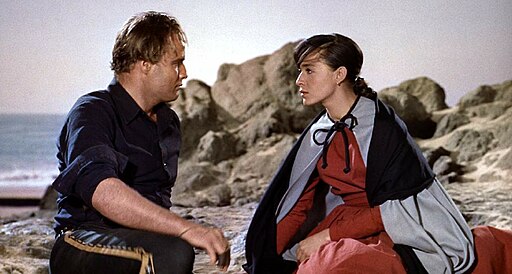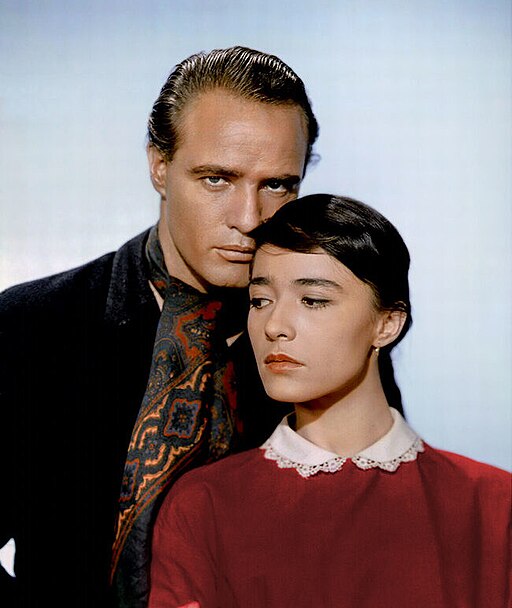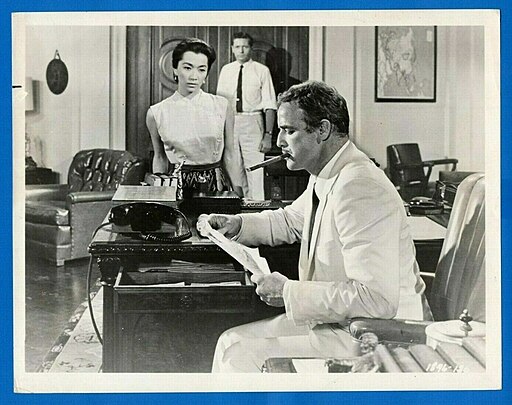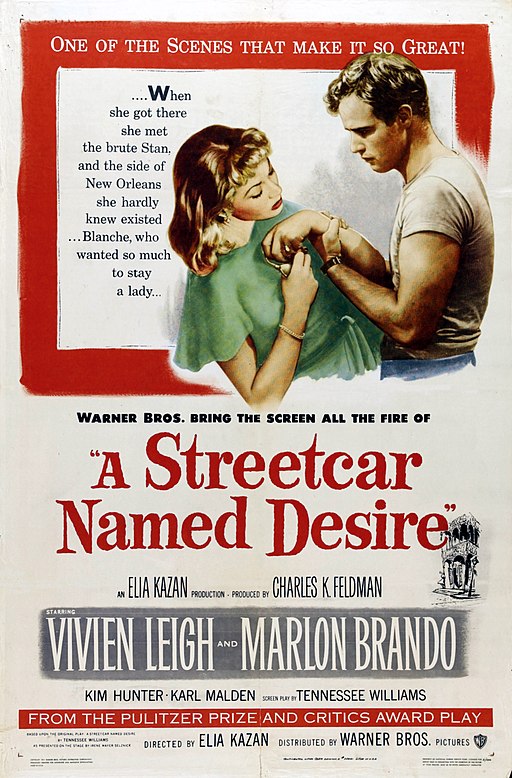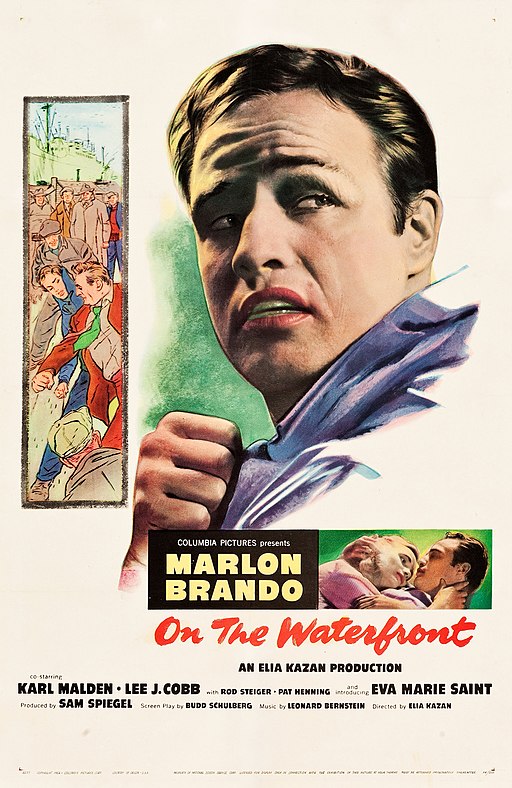Marlon Brando
back| Full Name | Marlon Brando Jr. |
| Stage Name | Marlon Brando |
| Born | April 3, 1924 |
| Birthplace | Omaha, Nebraska, USA |
| Died | July 1, 2004 |
| Buried | Brando was cremated, and his ashes were scattered partly in Tahiti and partly in Death Valley, California. |
| Married to | Anna Kashfi (1957–1959) - Movita Castaneda (1960–1962) - Tarita Teriipaia (1962–1972) |
| Children | Christian Brando - Miko Brando - Rebecca Brando - Simon Teihotu Brando Cheyenne Brando - Ninna Priscilla Brando - Myles Jonathan Brando - Timothy Gahan Brando - Maimiti Brando - Miko Castaneda Brando - Raiatua Brando - Lisa Brando |
| Notable films | A Streetcar Named Desire (1951) - On the Waterfront (1954) - The Godfather (1972) - Last Tango in Paris (1972) - Apocalypse Now (1979) |
Marlon Brando
The Godfather of Character Acting
Marlon Brando (1924-2004) revolutionized acting with his emotive power and method technique, becoming one of cinema's most distinguished figures.
Born in Omaha, Nebraska, he achieved fame with his Broadway debut in "A Streetcar Named Desire," later immortalizing the role on screen. Brando's performances in "On the Waterfront" and "The Godfather" earned him Oscars, showcasing his unparalleled ability to convey complex emotions.
Related
Marlon Brando (1924 – 2004)
Biography and Career Overview
Marlon Brando Jr., born on April 3, 1924, in Omaha, Nebraska, was an enigmatic force in American cinema, whose profound impact on the craft of acting is unrivaled. His early years were marked by turbulence and rebellion. The youngest of three children in a family with a history of alcoholism and a tradition of acting (his mother was a theatre administrator and an actress), Brando's upbringing was fraught with instability. This instability, however, nurtured a deep empathy and emotional depth that he would later draw upon in his acting.
From an early age, Brando exhibited a knack for mimicry and drama, traits that were often the only means to capture the attention of his distant parents. Despite his tumultuous relationship with his father, a traveling salesman who held his son in disdain for his sensitivity and artistic interests, Brando found solace in the arts. His life took a decisive turn when he was expelled from military school and subsequently moved to New York City to study acting at the legendary Actors Studio under Lee Strasberg and Stella Adler. It was here that Brando embraced method acting, a technique that would define his career.
Brando's breakthrough came with his electrifying performance as Stanley Kowalski in Tennessee Williams' "A Streetcar Named Desire" on Broadway in 1947, a role he reprised in the 1951 film adaptation, earning him his first Academy Award nomination. His portrayal was raw, intense, and animalistic, challenging the norms of screen acting and catapulting him into stardom.
Throughout the 1950s and 60s, Brando's career flourished with a series of critical and commercial successes, including "On the Waterfront" (1954), for which he won his first Academy Award, and "The Godfather" (1972), which earned him his second. Despite his success, Brando was notorious for his difficult personality on set, his disdain for the Hollywood system, and his demand for creative control.
Brando's personal life was as complex and tumultuous as his career. He was married three times—to Anna Kashfi, Movita Castaneda, and Tarita Teriipaia—and fathered at least 11 children, though the exact number is uncertain due to his numerous relationships. His family life was fraught with tragedy, notably the suicide of his daughter Cheyenne in 1995 and the conviction of his son Christian for manslaughter in 1990.
Beyond acting, Brando was deeply passionate about social issues, including the civil rights movement and Native American rights. In one of his most famous off-screen roles, he declined the Academy Award for "The Godfather" in protest against Hollywood's portrayal of Native Americans, sending Sacheen Littlefeather in his stead to make a statement at the Oscars ceremony.
Marlon Brando's later years were marked by declining health, obesity, and financial troubles, despite his continued acting work. He died on July 1, 2004, at the age of 80, in Los Angeles, California. The cause of death was reported as respiratory failure from pulmonary fibrosis, with additional complications from congestive heart failure. Brando's ashes were scattered in Tahiti and Death Valley, a testament to his love for these places.
Brando's legacy is that of a troubled genius who forever altered the landscape of film acting. His method approach brought a new realism and intensity to cinema, influencing countless actors and directors. Despite his personal demons and controversies, Brando remains an emblematic figure in American culture, remembered for his profound impact on the art of film and his impassioned advocacy for social justice.
Iconic Performances from Marlon Brando:
The Acting Style of Marlon Brando:
Marlon Brando's acting style was revolutionary, profoundly influencing the craft of acting and the way characters are portrayed on screen. His approach, deeply rooted in the techniques of method acting as taught by Stella Adler and inspired by the Stanislavski system, emphasized emotional truth, psychological depth, and realism. Brando's style was characterized by several key elements:
Emotional Depth and Authenticity
Brando's ability to convey deep emotional states with authenticity was unparalleled. He delved into the psychological complexities of his characters, bringing forth performances that were raw and moving. His portrayal of Terry Malloy in "On the Waterfront" exemplifies this, as he imbued the character with a vulnerability and inner turmoil that felt palpably real to the audience.
Physicality and Non-Verbal Communication
Brando was known for his exceptional use of physicality and non-verbal cues to express his characters' emotions and thoughts. His performances were not just heard but also seen in the smallest gestures, facial expressions, and movements. In "A Streetcar Named Desire," his portrayal of Stanley Kowalski utilized intense physical presence and animalistic charm to dominate the screen, making the character both menacing and seductive.
Improvisation and Spontaneity
A hallmark of Brando's acting was his penchant for improvisation, contributing to the spontaneity and freshness of his performances. He often strayed from the script to bring a more genuine and unpredictable element to his roles, as seen in his improvisation of dialogue and actions. This approach sometimes frustrated directors and co-stars but also led to iconic moments in cinema, such as the improvised "I coulda been a contender" scene in "On the Waterfront."
Voice and Diction
Brando's use of voice was another aspect of his innovative style. He manipulated his voice to suit the character, altering pitch, tone, and cadence to convey depth and nuance. His mumbled speech as Don Vito Corleone in "The Godfather" not only added to the character's mystique but also influenced the way actors approached vocal performance.
Psychological Complexity
Brando chose roles that explored the psychological complexities of human nature, often portraying characters with conflicted moral compasses or deep-seated emotional issues. He excelled at depicting the struggle between personal desires and societal expectations, bringing a layered and nuanced perspective to characters that might otherwise have been one-dimensional.
Influence on Acting
Brando's acting style marked a departure from the theatrical and often exaggerated performances of the time. He introduced a level of realism and intensity that was previously unseen in Hollywood, paving the way for future generations of actors. His method approach encouraged actors to fully inhabit their roles, using their own emotions and experiences to bring authenticity to their performances.
In summary, Marlon Brando's acting style was characterized by a deep immersion into his characters, a focus on psychological realism, and a use of physicality and improvisation that broke new ground in film acting. His legacy lies not only in the iconic roles he played but also in his profound impact on the craft of acting, influencing countless actors and changing the landscape of cinema forever.
Memorable Quotes from Marlon Brando:
Marlon Brando left behind a legacy not only of groundbreaking performances but also of memorable quotes, both from his iconic roles and his personal insights on acting, life, and society. Here are some memorable quotes attributed to him:
From His Iconic Roles
- "I coulda been a contender. I coulda been somebody, instead of a bum, which is what I am." - Terry Malloy in "On the Waterfront" (1954), capturing the character's regret and lost potential.
- "I'm gonna make him an offer he can't refuse." - Don Vito Corleone in "The Godfather" (1972), one of the most quoted lines in movie history, illustrating the character's power and influence.
- "The horror... the horror..." - Colonel Walter E. Kurtz in "Apocalypse Now" (1979), reflecting the character's despair and disillusionment with the brutality of war.
Personal Insights and Reflections
- On Acting: "Acting is the expression of a neurotic impulse. It's a bum's life. The principal benefit acting has afforded me is the money to pay for my psychoanalysis."
- On Life: "The only thing an actor owes his public is not to bore them."
- On Fame: "Privacy is not something that I'm merely entitled to, it's an absolute prerequisite."
- On Social Issues: "I believe in the will of the people, and I believe we should adhere to that principle and give them the right to make their own decisions, not have them made for them by a bunch of old, smelly men closed up in a room in Washington."
- On Himself: "I don't mind that I'm fat. You still get the same money."
Marlon Brando Fashion Style:
Marlon Brando's impact on fashion, particularly in the 1950s and 60s, is as significant as his influence on acting. His iconic portrayal of Johnny Strabler in "The Wild One" (1953) crystallized a rebellious, effortlessly cool image that would influence men's fashion for decades. Here's a closer look at the Marlon Brando style:
Leather Jacket
The black leather motorcycle jacket Brando wore in "The Wild One" became synonymous with the rebellious spirit of youth culture. His character's look—complete with the tilted cap, leather gloves, and biker boots—transformed the leather jacket from a practical piece of motorcycle gear into a symbol of rebellion, individualism, and rugged masculinity. This look inspired a generation and remains a staple in men's fashion.
T-Shirts and Jeans
Brando's casual off-duty style often included basic white T-shirts paired with classic blue jeans. This simple yet iconic ensemble highlighted his muscular physique and was revolutionary at a time when the T-shirt was considered an undergarment rather than a fashion statement. This laid-back aesthetic contributed to the popularization of the T-shirt as a key piece of casual wear.
Tailored Suits
Despite his reputation for casual attire, Brando also knew how to carry a suit with elegance and an edge of nonconformity. His roles in films like "The Godfather" showcased him in impeccably tailored suits, adding depth to his characters and influencing men's formal wear by blending traditional styles with a sense of power and authority.
Accessories
Brando's accessories, whether on-screen or off, added to his mystique. From the aviator sunglasses in "The Wild One" to the fedoras and bow ties in his more formal attire, his choice of accessories often added a finishing touch that combined sophistication with a hint of rebellion.
Cultural Impact
Marlon Brando's fashion influence extended beyond the screen, embodying a broader cultural shift towards more relaxed, expressive personal style. His natural, unapologetic approach to fashion—mixing comfort with a strong sense of identity—resonated with the public and helped to redefine masculinity.
Awards and Recognition:
Academy Awards (Oscars)
- 1951: Nominated for Best Actor for "A Streetcar Named Desire"
- 1952: Nominated for Best Actor for "Viva Zapata!"
- 1953: Nominated for Best Actor for "Julius Caesar"
- 1954: Won Best Actor for "On the Waterfront"
- 1957: Nominated for Best Actor for "Sayonara"
- 1972: Won Best Actor for "The Godfather" (Brando declined the award in protest against Hollywood's portrayal of Native Americans and in support of the American Indian Movement)
- 1989: Nominated for Best Supporting Actor for "A Dry White Season"
British Academy Film Awards (BAFTAs)
- 1952: Won Best Foreign Actor for "Viva Zapata!"
- 1953: Won Best Foreign Actor for "Julius Caesar"
- 1954: Won Best Foreign Actor for "On the Waterfront"
- 1973: Nominated for Best Actor for "The Godfather"
Golden Globe Awards
- 1955: Won Best Actor in a Drama for "On the Waterfront"
- 1973: Won Best Actor in a Drama for "The Godfather"
- **Additionally, Brando received several nominations over the years for his work in various films.
Cannes Film Festival
- 1952: "Viva Zapata!" was entered into the Cannes Film Festival, contributing to Brando's international acclaim.
Other Honors and Recognitions
- In 1961: Brando's directorial venture "One-Eyed Jacks" was nominated for a Golden Globe for Best Director.
- In 1973: Brando was awarded the Golden Globe Henrietta Award for World Film Favorite – Male.
- In 1999: He received the Lifetime Achievement Award from the Screen Actors Guild (SAG).
Movies Starring Marlon Brando
1950s
- "The Men" (1950): Brando's film debut as a paraplegic war veteran struggling to adjust to civilian life, showcasing his method acting prowess.
- "A Streetcar Named Desire" (1951): As Stanley Kowalski, Brando delivers a powerful performance in this adaptation of Tennessee Williams' play, exploring desire, brutality, and vulnerability.
- "Viva Zapata!" (1952): Brando plays Mexican revolutionary Emiliano Zapata, focusing on Zapata's rise from peasant to revolutionary leader.
- "Julius Caesar" (1953): A Shakespearean drama where Brando portrays Mark Antony, delivering the famous "Friends, Romans, countrymen" speech with surprising eloquence.
- "The Wild One" (1953): Brando is Johnny Strabler, a motorcycle gang leader whose arrival in a small town sparks rebellion and chaos.
- "On the Waterfront" (1954): As Terry Malloy, a former prizefighter turned longshoreman, Brando battles corruption on the docks in this Oscar-winning role.
- "Guys and Dolls" (1955): A musical film where Brando plays Sky Masterson, a gambler who falls for a Salvation Army worker.
- "The Teahouse of the August Moon" (1956): Brando is Sakini, a local interpreter in post-WWII Okinawa, in a comedic role that showcases his range.
- "Sayonara" (1957): A drama about interracial romance in post-war Japan, with Brando as a U.S. Air Force officer.
- "The Young Lions" (1958): Brando stars as a German ski instructor turned Nazi officer in this WWII drama, examining the war from multiple perspectives.
- "The Fugitive Kind" (1960): Based on Tennessee Williams' play, Brando is a drifter who becomes entangled with two women in a small Southern town.
1960s
- "One-Eyed Jacks" (1961): Brando's only directorial venture, in which he also stars as a bank robber betrayed by his partner and seeking revenge.
- "Mutiny on the Bounty" (1962): As Fletcher Christian, Brando leads a mutiny against the tyrannical Captain Bligh on the HMS Bounty.
- "The Chase" (1966): A drama where Brando plays a sheriff dealing with the fallout when an escaped convict returns to his small town.
- "Reflections in a Golden Eye" (1967): Brando is a closeted army major in a Southern military base, unraveling in this tale of repressed desire and obsession.
- "The Night of the Following Day" (1968): A crime drama featuring Brando as a kidnapper whose plan spirals out of control.
1970s
- "The Godfather" (1972): As Vito Corleone, the patriarch of a Mafia family, Brando delivers one of his most iconic performances.
- "Last Tango in Paris" (1972): A controversial film featuring Brando as a widowed American who embarks on an anonymous sexual relationship with a young Parisian woman.
- "The Missouri Breaks" (1976): A Western where Brando plays a "regulator" hired to hunt down horse thieves, showcasing his ability to inhabit eccentric characters.
1980s and Beyond
- "Apocalypse Now" (1979): As Colonel Kurtz, a renegade Army Special Forces officer, Brando embodies the horror and madness of the Vietnam War.
- "A Dry White Season" (1989): Brando plays a lawyer fighting apartheid in South Africa, a role that earned him an Academy Award nomination for Best Supporting Actor.
- "The Freshman" (1990): A comedy where Brando parodies his Godfather role as a mob boss involved in a unique scheme involving endangered species.
- "Don Juan DeMarco" (1995): As a psychiatrist treating a young man who believes he is Don Juan, Brando explores themes of love and fantasy.

